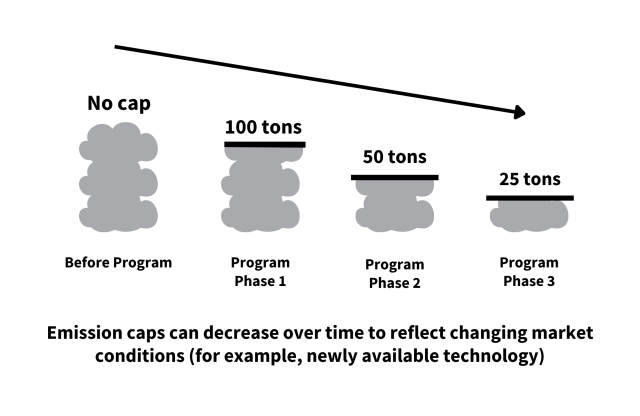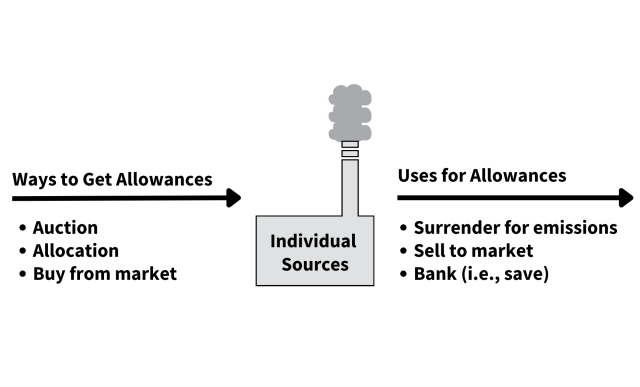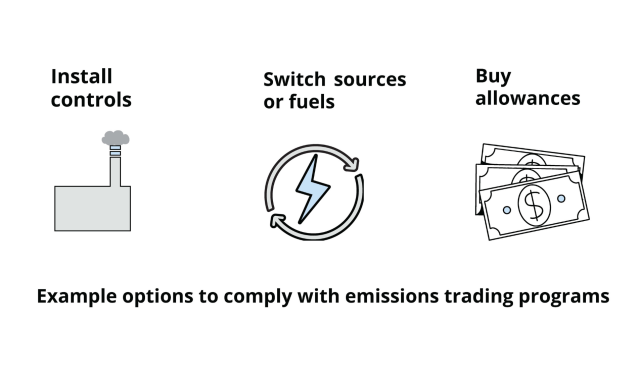How Do Emissions Trading Programs Work?
EPA’s emissions trading programs ensure that emission reduction goals are achieved while providing emissions sources flexibility in selecting a compliance path. This achieves environmental goals at lower compliance costs. The paragraphs that follow describe components of emissions trading programs and provide additional resources to further explore these program components.
Emissions Cap
Emissions trading programs first set an emission reduction goal: a national, state, or regional cap on the overall amount of emissions that emissions sources are allowed to emit into the air. This emissions cap is sometimes called a budget or an emissions limit. The cap is intended to incentivize effective pollution control and protect public health and the environment. By establishing emission caps, trading programs ensure that overall emission reduction goals are achieved.
Program approaches have evolved to ensure emissions reductions during certain periods or at specific locations. In some emissions trading programs, such as those under the Cross-State Air Pollution Rule (CSAPR), the emissions caps decrease over time in phases.

Federal policymakers can establish limits on how much a single state can emit beyond its budget when state-level allowance budgets exist within a broader budget or cap (e.g., state assurance levels in the Cross-State Air Pollution programs). At a local level, unit-level emission rates are required to serve as backstops that ensure reductions at specific emissions sources over certain periods.
Allowance Trading
Emissions sources participating in emissions trading programs, like power plants, receive allowances that authorize them to emit up to a certain amount of pollution over a specific amount of time. For example, in EPA’s Acid Rain Program, each allowance authorizes an emissions source to emit one ton of sulfur dioxide during an annual compliance period. Depending on the program, emissions sources receive allowances in different ways, usually freely allocated or auctioned. Once an emissions source has an allowance, it can choose to use it to cover its emissions, sell it in the market, or bank (i.e., save) it to cover future emissions.

Program approaches related to allowance trading have evolved to ensure emission reductions at specific locations and during certain periods. Bank adjustments, also known as bank recalibrations, minimize the accumulation of saved allowances available for purchase. Dynamic budgets periodically adjust the number of allowances and in doing so, right-size the program’s stringency to evolving real-world conditions and available science. Learn more about allowance trading on Allowances: The Currency of EPA's Emissions Trading Programs.
Flexibility in Compliance Approach
Emissions trading programs provide flexibility for emissions sources to select a compliance approach. The ability to trade allowances by selling or purchasing them from the market provides an incentive to reduce their emissions below the cap so that they can sell or bank surplus allowances. The ability to bank allowances for later use often means that emissions sources reduce emissions below the cap in early years of the program, resulting in more emission reductions sooner than required.
Emissions sources can choose among many options to comply with the cap. For example, an emissions source can:
- Install emission reduction control technologies, such as scrubbers or selective catalytic reduction (SCR), to remove emissions before they leave the smokestack.
- Upgrade and/or optimize existing controls so they more effectively reduce emissions.
- Improve plant efficiency so that less fuel is used, and fewer corresponding emissions are produced per unit of energy.
- Switch to alternative fuels that release fewer emissions.
- Utilize lower-emitting or more efficient emissions sources.
- Buy surplus allowances generated from reductions elsewhere.

Flexibilities in compliance approaches can be paired with program design features to ensure emission reductions at specific locations or during certain periods when required. When added to emissions trading programs, these design features can help balance efficiency in emission reductions with other program goals related to when, how, and where emission reductions occur.
Compliance and Accountability
Emissions sources’ compliance with emissions trading programs is determined using emissions and allowance data. Effective emissions trading programs require emissions sources to monitor and report their emissions through comprehensive and accurate methods like continuous emissions monitoring systems. These monitoring systems also enable regulatory authorities to review data and make it publicly available.
Tracking allowance data enables emissions sources to trade allowances to meet compliance while also allowing regulators to evaluate compliance. To comply with emission trading programs, individual emissions sources must hold enough allowances at the end of a compliance period to cover their emissions from that same period. If an emissions source does not have enough allowances, it incurs an automatic penalty. As an example, Acid Rain Program emissions sources with a shortage of allowances at the end of a compliance period must surrender an equal amount of future compliance period allowances and pay an inflation-adjusted penalty on a dollar-per-ton basis.
Continue to learn why emissions trading programs work or explore more information on the development and implementation of emissions trading programs.
